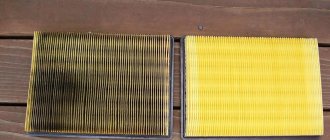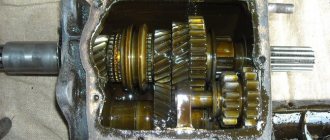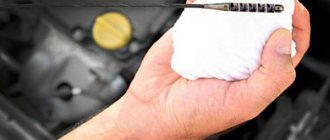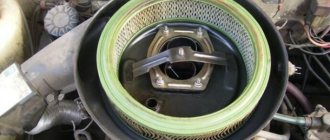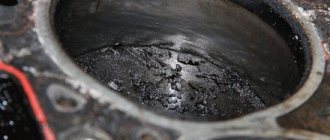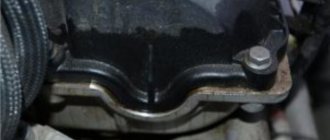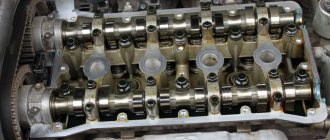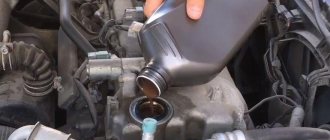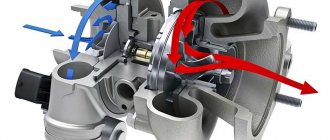WHAT DOES THE BREATH DO?
The task of the breather in a car design is to connect the engine sub-piston space with the atmosphere.
Additionally, the breather is installed in the valve cover of the block head. During operation of the power plant, the movement of components, mechanisms, and lubricant leads to an increase in pressure inside the crankcase and under the cover. In addition, crankcase gases accumulate in the sub-piston space, which also increases the pressure.
Piston rings are not able to ensure complete tightness of the combustion chamber, so some of the working gases break through and enter the sub-piston space.
The operation of the motor is accompanied by temperature changes, which causes condensation to form inside. The accumulation of moisture inside the motor is unacceptable, since it is the main cause of corrosion.
A mixture of working gases that have broken into the crankcase, moisture, and oil particles that are mixed in contact with the lubricant are called crankcase gases. An increase in pressure inside the crankcase is usually accompanied by a deterioration in engine performance, since gases create additional resistance to components and mechanisms.
If gases accumulate in large quantities in the sub-piston space, then they break through leaks and “weak” components - oil seals, dipstick, seals, etc.
Therefore, it is important to equalize pressure and gas removal. And this is done by the breather, which is essentially an air valve
Note that this element is used not only on the engine, it is also used in gearboxes and rear axles.
In addition to maintaining pressure in the cylinder block, many car enthusiasts use the breather to diagnose the engine. It helps determine the degree of wear of the cylinder-piston group and the position of the rings.
When engine components wear out or piston rings become coked, a large amount of gases enters the sub-piston space. And thanks to the breather, this is clearly noticeable by the smokiness of the crankcase gases escaping. If the CPG is in good condition, there is practically no smoke in the crankcase gases.
Breather repair and maintenance
Due to its low cost, as well as ease of removal/installation, breather repair almost always comes down to replacing it. But even forgetful car owners who carry out its maintenance from time to time will not need this, since there is simply nothing to break.
All its maintenance comes down to timely cleaning. It is enough to wipe the outside with a rag, and if the stains are old, you will have to use a knife, screwdriver or scraper.
Cleaning the inside is a little more difficult, but still very simple. The breather must be removed (it can be bolted or firmly seated “in tension”) and cleaned with a primitive cleaning rod, which can be made from a piece of wire. We do the same with the oil trap mesh: in rare cases, when it is very clogged, mechanical cleaning will not be enough. And then you need to burn it by pouring just a little gasoline, or soak it in aggressive chemicals for several hours.
Assembly, as is quite predictable, is in reverse order. Therefore, the entire process will not take much time and will not require special tools or skills.
However, this is best done during a seasonal oil change or when undergoing regular maintenance. On most cars with average mileage, it is enough to carry out this simple operation twice a year. But it is the engine breather that confirms the immutable truth: there are no small details in a car, especially a modern one.
Operating principle of the crankcase ventilation system
Oil smells like gasoline reasons
In order to understand why oil is squeezed out of the breather, I propose to briefly consider the principle of operation of the oil system. Not many people know, but for proper operation of the engine, ventilation is necessary, since during its operation gases collect in the crankcase, and now we are not talking about exhaust gases. To ensure the removal of these gases, old cars used a so-called crankcase ventilation system, which after some time became known as a “breather.” With the help of a breather, engineers were able to ventilate the crankcase and thereby relieve the pressure that forms during engine operation. However, the system turned out to be ineffective, since tiny oil particles penetrated the breather along with excess pressure and gases.
The issue of penetration of “oil dust” into the breather was partially resolved by means of a special mesh that traps oil particles and does not let them into the breather. However, despite this, some of the oil vapors still penetrate into the breather, creating certain difficulties for owners. A small amount of oil that has penetrated into the breather is not considered anything terrible, however, if oil flows out of the breather in large quantities, this is a reason to seriously think about the technical condition of the engine.
Why does crankcase pressure increase?
How long does it take to change the oil in manual and automatic transmissions?
Having noticed oil leaks in the engine compartment and/or a decrease in the oil level in the crankcase, it is necessary to accurately determine that the diesel engine is breathing. This can be done in the following way. It is enough to unscrew the oil filler cap on a warm diesel engine. If you notice bluish smoke coming from the throat, then the problem is obvious.
Cylinder piston group and cylinder head
The main reason that a diesel engine is breathing is the wear of the cylinder-piston group. During the operation of the internal combustion engine, scuffs form on the cylinder walls, the cylinders themselves gradually break and acquire a changed shape of the walls, and the piston rings wear out or break. As a result of heating, the thermal gaps between the piston and the cylinder walls become too large.
In addition to reducing the efficiency of the seal, wear of the rings and their coking are imposed, which deprives the rings of mobility. In such conditions, engine oil enters the combustion chamber abundantly, and the diesel engine emits blue smoke. Also, the gases formed during the combustion of the fuel-air mixture and the engine oil entering the cylinders actively fill the engine crankcase.
If the diesel engine is very worn out, then a major overhaul is necessary, which will mean boring the cylinders, replacing pistons, rings, etc. Accurate diagnosis of CPG problems requires measuring compression to determine the spread of indicators across the cylinders.
In the event that the diesel engine does not breathe much and the malfunction is only at the initial stage (wear of the cylinder walls is within acceptable limits), some auto mechanics resort to the method of decarbonizing the piston rings. This measure is considered temporary, since further long-term operation of the unit after decarbonization of the rings should not be expected. The best solution would be to replace the rings with new ones.
A diesel engine can also vent due to wear of valves, guide bushings, valve seals, etc. Similar to piston malfunctions and ring decarbonization, timing problems can only be effectively eliminated by comprehensive repairs. Replacing valve seals alone does not have a lasting effect.
Engine crankcase ventilation system
Second on the list of main reasons why a diesel engine is breathing is a clogged crankcase ventilation system. The symptoms of a decrease in the throughput of this system resemble wear of the CPG: increased consumption of engine oil, diesel smoking with blue smoke, etc. In some cases, it is possible to normalize engine operation and eliminate excess oil consumption by cleaning the breathers.
Replacing the breather of the gearbox VAZ 2108
Frequency of oil changes in the VAZ box 2108
-2109-21099
- 1
–
Transmission - 2
– oil drain plug
The frequency of oil changes is every 75,000 km or every 5 years.
Transmission housing capacity
- five-speed – 3.3 l;
- four-speed - 3.0 l.
It is recommended to drain the oil immediately after the trip, while gearbox has not cooled down.
Maintain oil level
always closer to the upper mark, but it should not exceed the upper mark, otherwise oil may leak from
the gearbox
.
Cleaning the engine breather of a VAZ 2108 2109 21099. If the engine presses oil through the distributor or blows up the air filter, you need to clean the breather. The lower mark indicates the minimum permissible oil level
.
Cleaning the breather of VAZ 2108 2109 21099 — logbook. If the oil level drops below this mark, the gears will not be sufficiently lubricated and VAZ 2108 gearbox will quickly fail.
What is a breather in a car and how it works
Why does oil get into the air filter, the main reasons, what to do, how to avoid the problem Why does oil get into the air filter and what to do
What is a breather for?
The device reduces pressure when gaseous substances are released from the engine housing, and it helps to quickly reduce pressure. In the automotive world you can find different cars. In some models and brands, breathers are installed not only in the engine, but also in the gearbox, for transfer cases, gearboxes and the rear axle of the car.
The principle of operation of the breather in the engine
Today, a breather valve to reduce pressure is very often installed on SUVs. This is due to the fact that the device is suitable for off-road driving. Breathers prevent oil leakage. Heated engine oil expands, causing engine pressure to increase.
The pressure in engines or in other automotive devices must find a way out. This causes oil to leak out through various gaskets and gaps. To prevent oil leakage, breathers are installed.
All breathers in the car should be checked periodically. Due to the constant movement of oil, debris and dirt remain in it. Breathers must be properly removed and cleaned of contaminants. If it is too dirty, then it must be replaced with a new device. Before installing a new valve, be sure to thoroughly clean the installation area of dirt and debris. This is done to prevent debris from getting into the new device.
Breather in gearbox
The gearbox must convert the torque in the engine and also change the traction force. It often happens that the gearbox starts to work poorly due to the fact that the gearbox breather is clogged. To avoid any damage, you should clean not only the breather in the engine, but also all the others that are installed in different parts of the machine.
In the gearbox, the breather is located on the gearbox housing cover. Sand or dirt getting into the breather will cause the wheel mounted on the secondary shaft to jam. As a result, wear of bearings and synchronizers increases. It is necessary to wash the breather during each technical inspection, or even more often. If the valve is clogged, the pressure in the gearbox will increase, which will lead to oil leakage through the seals.
Bridge breathers
There is oil inside each axle that connects the wheels. The internal cavity must contact the external environment, and it does this through the breather. With the help of this valve, an increase in pressure inside the bridge itself is eliminated.
Oil pressure rises when it heats up during forward gear operation. The breather also performs a protective function. It protects the bridge from water entering it when the car overcomes a water barrier. There is also a special hole in the middle of the bridge through which oil drains.
Particular attention should be paid to the rear axle crankcase breather. It is located on the rear axle boat, on the right side, at the top
As a result of this valve being clogged, oil may leak. To get rid of this problem, you need to clean the breathers from dirt. You also need to check the free movement of the breather cap. It should move in all directions.
After cleaning the breather, you should check it again after a short run of 20 km. If traces of oil are detected again, this will indicate a malfunction of the device that needs to be replaced. The rear axle breather must always be in good condition, because it plays an important role in the operation of the entire vehicle.
Share information with friends:
Preventative work
Some motorists are wondering: why clean the breather? This is done in order to avoid problems with the operation of car components; it is necessary to clean the breather in a timely manner. Such actions will allow you to maintain the permissible pressure level, and as a result, stable and trouble-free operation of the car. It is recommended to carry out cleaning at every technical inspection (MOT), and in some cases even more often. The cleaning process itself looks like this:
- removal of pipes and hose. All pipes and hoses coming from the “breathing valve” are removed; in some models you will also need to remove the air filter housing;
- removing the breather cover;
- cleaning work. Now you can begin cleaning the valve cap and tube.
- installation work. Assembly is carried out in reverse order.
This is how cleaning is done. The procedure is quite simple, and you can do it yourself with your own hands, without the need to visit a service center.
Sources
- https://prometey96.ru/tyuning/sapun-kpp.html
- https://7gear.ru/news/sapun.html
- https://shokavto.ru/chto-takoe-sapun-v-avtomobile/
- https://AvtoNov.com/%D1%81%D0%B0%D0%BF%D1%83%D0%BD-%D0%B4%D0%B2%D0%B8%D0%B3%D0%B0% D1%82%D0%B5%D0%BB%D1%8F-%D1%87%D1%82%D0%BE-%D1%8D%D1%82%D0%BE-%D1%82%D0%B0 %D0%BA%D0%BE%D0%B5/
- https://kalina-2.ru/remont-vaz/sapun-korobki-peredach-vaz-2110
- https://avto-kontinent.ru/vesta/sapun-korobki-peredach-vaz-2110.html
- https://DriverTip.ru/osnovy/chto-takoe-sapun-v-avtomobile-kak-rabotaet.html
Engine breather
Some novice drivers are stumped by the question “engine breather and what is it,” because recommendations for the operation and care of a vehicle often mention this important element of the engine.
In addition, the breather often helps diagnose important problems associated with the power unit: the fact is that problems with this element can subsequently cause engine problems, which can then lead to expensive repairs.
That is why the car owner simply needs to know all the aspects and characteristics of the device, as well as have an idea of how to properly prevent disruptions in its operation, because the breather valve, which does not seem like a significant detail at first glance, is of great importance for the proper operation of the power unit.
What is its purpose?
To understand what a breather is, it is recommended to find out what it is for, since this is directly related to its operating principle.
The main task of this device is to reduce pressure in the engine crankcase.
While the car is running, a lot of gases accumulate in the crankcase, which over time create high pressure. If they are not released in time, the engine may stop working, since high pressure will support the pistons, and gas will begin to escape through any other hole. To prevent this from happening, this valve is installed.
Another significant function of the device is to reduce the temperature inside the engine and ventilate it.
Based on the operation of this unit, one can draw conclusions about problems in the operation of the motor.
In normal operating condition, a slightly transparent, barely noticeable smoke can be seen from the unit. There are situations where the engine constantly throws out oil through the breather. This is a common cause of not only valve clogging, but also other technical problems.
The breather valve is an important element that allows communication with the external environment of a closed container. It allows you to equalize the pressure inside the internal combustion engine: if it drops sharply, fresh air will enter through the valve, which will eliminate the difference between the external, atmospheric, and internal pressure created in the crankcase cavity.
Installation location
The breather valve in a car is usually located:
- directly in the engine;
- inside the rear and front axle structures;
- at the checkpoint.
Principle of operation
Regardless of the installation location, the functions of the breather remain the same.
In other words, the valve allows the structural components of the car to “breathe”, from which working fluids are not allowed to leak and into which small particles from the outside should not enter.
While the engine is running, the oil inside the crankcase tends to heat up, which leads to an increase in engine temperature.
During this, the air in the crankcase begins to expand and creates pressure that must be relieved.
When cooling, on the contrary, the pressure in the crankcase quickly drops, which is why air from outside tries to break through any available holes. In order to counteract such phenomena and completely safely equalize the pressure on the engine, this device is installed.
Why do you need to clean the valve?
The external conditions created during the operation of the breather valve often lead to the accumulation of dust and dirt in it, which interfere with its normal functioning. Because of this, excess or, conversely, insufficient pressure occurs, leading to oil leakage.
The breather should be replaced with a new one in cases where it is too contaminated, and before installing a new unit, it is recommended to thoroughly clean the place where it is installed, which will avoid rapid contamination again. Breathers of other important components of the car also need to be cleaned in a timely manner to prevent car malfunctions.
Important
The breather is an important element that helps the car operate properly, but to prevent breakdowns it is recommended to clean or change it in a timely manner.
A faulty valve can lead to various problems:
- risk of gearbox leakage;
- rapid wear of synchronizers and much more.
Regular cleaning of the valve will help protect the oil from deterioration in its lubricating and protective properties, and therefore will extend the life of the iron horse for a long time.
Where is the breather installed?
Breathers on a car are installed:
- in the engine itself;
- in the gearbox device;
- in the design of the front and rear axles;
Note that the functions of these devices are almost the same regardless of the installation location. It should be added that the valve also has an additional filter that prevents mechanical particles, dirt and moisture from entering the engine along with the outside air.
After stopping the engine and stopping the operation of other components, as well as when it gets into water (important for SUVs), cooling occurs. When cooling, the pressure in the container drops, a pressure difference arises again and outside air tries to break through through the gaskets, etc. To counteract these phenomena and safely equalize pressure on the engine, gearbox, etc. breathers are installed. It turns out that the valve prevents water and dirt from entering the power units when the pressure drops, and also does not allow the gaskets to be squeezed out and the working fluid (lubricant) to leak out when excess pressure occurs.
Device
The breather is essentially a valve that bleeds air from the engine. As the pressure increases, it begins to allow a certain amount of gases to pass through it. The greater the pressure, the more air can pass through it. To prevent atmospheric air from entering inside, the valve is capable of flowing only in one direction. But on some cars this process is reciprocal. In such versions, a filter is installed in the valve to prevent dust from getting inside the motor.
Most often, the breather is located next to the oil filler neck. Much less often you can find options with its location on the side of the cylinder block. From the outlet pipe there is a hose connected to the air filter housing. This arrangement is typical for all cars. It may differ only in small nuances due to the characteristics of the body. Sometimes there are 2 pipes, in which case the second hose is connected to the injector.
Purpose
What is an engine breather? Before answering this question, it is important to understand what it is intended for. This is directly related to the principle of its operation. The main task of this device is to reduce the pressure in the engine crankcase. When the power unit operates, various gases collect in the crankcase. Gradually they accumulate and create quite a lot of pressure. If you do not bleed them, the engine may stop, the pressure will back up the pistons. In this case, the gas will seek an exit through any available hole. To prevent this from happening, a breather is installed.
This device is also used to ventilate the crankcase. Unnecessary gases are removed from it. Thus, the temperature inside the engine is slightly reduced. The engine breather has two tasks: ventilation and releasing excess pressure. In some cases, the operation of the breather can indicate the presence of problems in the engine. If the rings are stuck or the piston is damaged, gray smoke characteristic of the exhaust will fly out of the hose. This way you can diagnose these faults without disassembling the engine. In normal condition, a slightly noticeable transparent smoke comes out of the breather.
The principle of operation of the breather in the engine
Today, a breather valve to reduce pressure is very often installed on SUVs. This is due to the fact that the device is suitable for off-road driving. Breathers prevent oil leakage. Heated engine oil expands, causing engine pressure to increase.
The pressure in engines or in other automotive devices must find a way out. This causes oil to leak out through various gaskets and gaps. To prevent oil leakage, breathers are installed.
All breathers in the car should be checked periodically. Due to the constant movement of oil, debris and dirt remain in it. Breathers must be properly removed and cleaned of contaminants. If the breather is too dirty, then it needs to be replaced with a new device. Before installing a new valve, be sure to thoroughly clean the installation area of dirt and debris. This is done to prevent debris from getting into the new device.
Why you need to clean the breather
Operating under the conditions described above means that the breather may become clogged. The release of oil through the valve is accompanied by the subsequent accumulation of dust, which clogs the valve passage. As a result, when heating, excess pressure is created or insufficient pressure when cooling, which leads to oil leakage through the oil seals and gaskets of the engine and other units.
To troubleshoot the problem, the breather must be removed for cleaning or replacement. It is recommended to replace the engine or gearbox breather with a new one if it is very dirty. Before installing a new breather, it is necessary to thoroughly clean the installation site. This will avoid its rapid re-contamination.
Troubleshooting
The first thing you need to pay attention to is the color of the exhaust, blue or black smoke, a sign of burnt valves or problems with rings. Next, you should check the compression in all cylinders. The value on gasoline internal combustion engines should be within 11-13 MPa. Disconnect the pipes from the valve covers, air intake and breather
Assess the degree of contamination. If the pipes are very dirty or clogged with oil deposits, use gasoline to clean them or a special carburetor cleaner. Check the condition of the oil separator. Unscrew the required bolts to get to this unit. Remove the oil separator and assess its condition. If necessary, clean or rinse followed by drying. Inspect and, if necessary, flush the breather valve. There are situations when the valve gets stuck, resulting in exhaust gases entering the crankcase and creating excess pressure. Remove the part and wash it; in most cases, this will resolve the issue of squeezing oil out of the breather.
Helpful advice! To distinguish stuck rings from a burnt-out valve, it is enough to perform several manipulations. After checking the compression in the cylinders, determine the cylinder with the lowest value. Then inspect the spark plug of this cylinder; if the rings are lodged in this cylinder, the spark plug will be covered with a thick oil layer. If the valve is burnt out, the spark plug will appear normal without any major abnormalities.
Finally…
The problem of oil escaping through the breather worries many motorists and causes a lot of trouble, but with timely detection of the problem and the right approach, serious consequences can be avoided
It is important to ensure that the oil level is normal, as soon as you find that the engine is taking oil, monitor its level and constantly monitor that it does not fall below the permissible level
Also pay attention to the breather and filter; oil on the air filter in large quantities also does not bode well. Regularly monitor the condition of the engine and all systems, and also promptly correct any malfunction
This will save you from engine overhauls and unnecessary waste.
DESIGN FEATURES
Previously, the breather was a regular fitting with a hose attached to it and directed downwards. This design ensured the removal of crankcase gases to the atmosphere. To prevent oil from escaping, an oil separator was installed in front of the breather. This element changed the trajectories of gas movement, while the oil, due to inertia, settled on the walls of the oil separator and flowed into the pan.
Crankcase ventilation system of VAZ 2111: 1. Engine crankcase. 2. Breather. 3. Hose from the breather to the valve cover pipe. 4. Oil separator under the valve cover. 5. A thin hose from the valve cover to the fitting with the throttle body nozzle. 6. Fitting with a jet on the throttle valve block. 7. Thick hose from the valve cover to the inlet pipe. In modern cars, to improve environmental friendliness, a whole system for removing these gases is used. Thanks to it, they are not released into the atmosphere, but are fed into the cylinders, where they burn.
This system includes:
- Breather.
- Oil separators.
- Pipes.
It is noteworthy that the crankcase gas exhaust system uses several oil separators - labyrinth, centrifugal, and mesh.
The breather is located in various places in the lower part of the engine block. It can be either a separate element or act as a housing for the probe.
The breather is a very simple element in design, but the performance of the engine depends on it. If you turn it off, then within a few minutes the increased pressure will squeeze out the oil. If the oil comes out through the dipstick, then you just need to restore the lubricant level and wipe the engine compartment. But if the oil presses through the crankshaft oil seals, then replacing them is impossible.
There are no moving parts in the breather, so there is nothing to break in it. But it still requires maintenance. The oil separator is not able to catch all the oil and oil particles remain in the gases. Some of them settle on the inner walls of the breather along with soot and pollutants. Gradually, the diameter of the tubes decreases, which impairs crankcase ventilation. In winter, frozen water is added to the dirt on the walls.
On some cars, the crankcase ventilation system provides for the supply of gas to the valve covers, where they additionally pass through an oil trap mesh before entering the cylinders. The honeycombs of this mesh are also clogged with dirt, so the throughput is reduced. This “results” in pushing through the camshaft seals.
SERVICE
To eliminate the possibility of the seals being pressed through, you need to periodically clean the engine ventilation system. If you remove dirt twice a year, there will be no problems with the work, since the dirt is removed with a rag.
Dirty breather of Skoda Octavia
You should start with the breather itself. In some engines it is secured with bolts, while in others the breather is tightly seated in the seat.
After removing the breather wall, carefully wipe it with a rag. If the contamination is strong, then they are removed with wire or a screwdriver. Before installing the breather, wipe the seat.
We wash and clean the ventilation system pipes with a cleaning rod made of rags and wire.
The oil trap screen installed in the valve cover also needs to be cleaned. If it is slightly dirty, just wiping is enough.
If the mesh is heavily contaminated with deposits, then everything will have to be removed using a knife, screwdriver, or wire. You can also simply burn out the deposits. To do this, pour a little gasoline onto the grid and set it on fire.
Such simple actions allow you to keep the crankcase ventilation system, which includes the breather, in working order and prevent the seals from being pressed or oil being squeezed out through the dipstick.
Breather VAZ 2109
The engine crankcase ventilation system of the VAZ 2108 2109 21099 is designed to ventilate the engine crankcase from gases that have broken into it from the cylinders. From the engine crankcase, gases are supplied through a hose to the valve cover, where they pass through an oil separating mesh and are sucked into the carburetor air filter. If the oil separating mesh becomes dirty and oil no longer deposits on them, the oil will enter the carburetor air filter. If the air filter is filled with oil, then it is necessary to clean the crankcase ventilation system. But as a rule, many people often do not do this, but disconnect the hose between the valve cover and the air filter and direct it to the side. The hole in the air filter is plugged with a champagne cork - and all is well. It seems that the air filter is clean and the oil is no longer spitting out as much. However, this is for the time being. Sooner or later, the crankcase ventilation system will become completely clogged, and then the VAZ 2108 2109 21099 engine will begin to press oil. As a rule, it goes into the distributor through the camshaft oil seal.
Presses oil into the VAZ 2109 distributor
In general, the prerequisites for cleaning the crankcase ventilation system (breather) are as follows: — The air filter is in oil; — Distributor in oil. The procedure for cleaning the breather of a VAZ 2108 2109 21099: 1) First, you need to disconnect all the tubes from the engine valve cover and remove the carburetor air filter.
Disconnect the tubes from the cover
2) Unscrew the gas pedal cable from the engine cover.
Unscrew the fastening of the gas pedal cable
3) Unscrew the two nuts securing the valve cover to the engine and remove it.
Removing the valve cover of the VAZ 2109
4) The lid will be covered in dirty oil all over the inside.
Valve cover VAZ 2109
It will be necessary to remove the cover covering the oil separating nets and clean them from adhering dirty oil.
Remove the cover of the oil separating mesh
To clean, you need to disassemble the nets and bathe them in kerosene or gasoline until they are clear of adhering oil.
Oil separating mesh for breather VAZ 2109
Some people pour gasoline on the meshes and set them on fire - the oil burns out and then just wipe the meshes a little with gasoline and that’s it.
Burning the oil out of the mesh
5) You also need to be patient and try to clean the valve cover itself of the VAZ 2108 2109 21099 from adhering oil, especially the place where the oil separating mesh is installed.
6) There is also a small outlet on the valve cover, which is connected through a tube to the throttle body of the carburetor. In my case, it was also completely clogged with hardened oil and I had to clean the outlet with a thin steel wire for about half an hour. 7) Then, you need to put the cleaned oil separating mesh of the VAZ 2108 2109 21099 breather in place and close it with a lid.
The oil separating mesh is cleaned
 Before replacing the valve cover, it is necessary to clean the surface of the engine from old sealant and dirt. It is also necessary to wipe the rubber gasket of the valve cover itself. 9) Then apply a thin layer of sealant along the edges of the valve cover to improve sealing. We put the cover in place and tighten the nuts securing it. 10) We connect all the tubes back, fasten the gas pedal cable and put the air filter in place. 11) For better sealing, it is better to give the sealant a couple of hours to dry before driving the car. The work on cleaning the breather of the VAZ 2108 2109 21099 is now completed. You will immediately notice that the engine will consume less oil during operation and will need to be topped up less.
Before replacing the valve cover, it is necessary to clean the surface of the engine from old sealant and dirt. It is also necessary to wipe the rubber gasket of the valve cover itself. 9) Then apply a thin layer of sealant along the edges of the valve cover to improve sealing. We put the cover in place and tighten the nuts securing it. 10) We connect all the tubes back, fasten the gas pedal cable and put the air filter in place. 11) For better sealing, it is better to give the sealant a couple of hours to dry before driving the car. The work on cleaning the breather of the VAZ 2108 2109 21099 is now completed. You will immediately notice that the engine will consume less oil during operation and will need to be topped up less.
Let's sum it up
Taking into account the above information, it becomes clear that even with its apparent simplicity, the breather of a gearbox, engine or axle performs a rather important function. This means that the condition and proper operation of this element must be monitored.
This is especially true for SUVs, trucks and special equipment, where in addition to gearboxes and internal combustion engines, breathers are installed on bridges. Such machines are often operated in harsh conditions, as a result of which the gearbox or axle pressure reduction valve may become dirty or fail more often (especially the rear axle breather).
Finally, we note that if the owner notices oil leaks from the engine, gearbox, axles, and other components and assemblies through gaskets and seals, this may indicate problems with the breather. If the valve is clogged or faulty, pressure increases in the closed cavity, which causes lubricant leakage.
Also, the unit or assembly itself may stop working normally, which subsequently leads to serious damage. For this reason, it is necessary to clean the breathers installed on different units and elements of the car at every service. If the car was driven off-road, it is recommended that after such trips you immediately wash the breathers to remove dirt and sand.
